Notes: When the Abbotsbury branch opened on 9 November 1885, the new station at Upwey Junction was not ready, so passengers for the branch had to travel to the original Upwey station from where they were taken by horse-drawn carriage to Broadway station (ultimately known as Upwey) to join a Weymouth - Abbotsbury train.
The new Upwey Junction station eventually opened a little over five months later on 19 April 1886, the original Upwey station closed on the same day.
The main line had two facing platforms spanned by a lattice footbridge. The branch had a single platform on the up side of the line immediately behind the down main line platform, but at a lower level. The branch line was steeply graded through the station; at its south end the platform was about a foot lower than the main line platform, but at the north end it was about four feet lower before the ramp. Because of the difference in height, there was a fence along the back of the mainline platform to prevent accidents.
The down main line platform and the branch platform shared a single timber building with a hipped roof, but on the branch side it stood on several courses of stone blocks because of the difference in level, with steps down to the platform. The building was faced with vertical timber weatherboarding. There was a canopy protecting both platforms, with a fretted valance that followed the line of the hipped roof around the ends of the building. The up main line platform had a smaller timber waiting shelter with a sloping roof and a narrow canopy with a deep valance.
The junction was controlled by a signal box at the south end of the up platform. The station did not handle goods traffic because of its position, all goods being dealt with at Broadway which was less than half-a-mile away. The station did, however, handle some parcels, and a corrugated iron shed was provided for this purpose on the down platform at the south end of the station building.
After closure of the branch to passenger traffic on 1 December 1952, the line to Upwey – the first station on the branch, originally known as Broadway - remained open for goods traffic. With only the main line platforms in use, the former junction station was renamed Upwey & Broadwey. The branch platform remained in good condition during this period although devoid of nameboards. It was used as the main access point to the main line platforms. The track through the station was re-laid with new ballast and concrete sleepers in the late 1950s. Upwey Goods closed on 1 January 1962 and the track was lifted in 1965. The junction was finally severed on 6 September 1966 but the signal box remained open until 1 March 1970.
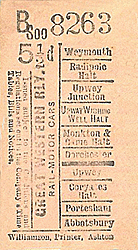 |
All of the station buildings were removed, probably in the late 1960s, and were replaced with two bus shelters. The station name was once again changed to Upwey on 12 October 1980. Prior to the extension of electrification from Bournemouth to Weymouth in 1988 the station was refurbished in trademark Network SouthEast colours with red lighting poles, station benches and monitor screens for train arrivals. Rubble from the rebuilt Weymouth station was used to fill in the former branch line trackbed up to platform level for use as a car park, and the approach road was extended into it.
South West Trains operate services between London Waterloo station and Weymouth via Basingstoke, Southampton, Bournemouth and Poole. Services are operated almost exclusively by Desiro units. First Great Western operates services between Bristol Temple Meads and |
Weymouth via Bath Spa, Westbury and Yeovil Pen Mill. Some services originate from Westbury, with passengers having to change to reach Bristol. Services are operated by Class 150, Class 153 or Class 158 diesel multiple units. In past years on summer Saturdays, Class 31 locomotives and Mk.2 coaching stock have been hired from FM Rail to cater for extra passengers and holidaymakers, but the demise of the charter company has seen this operation cease, at least for the time being.
BRIEF HISTORY OF THE ABBOTSBURY RAILWAY
The Great Western Railway opened a mixed gauge line to Weymouth on 20 January 1857; this allowed trains from both Paddington (broad gauge) and Waterloo (standard gauge) to operate a service into the town. The Weymouth & Portland Railway Act was passed in 1862 authorising the extension of this line to Weymouth Quay; services would be provided jointly by the GWR and LSWR, and a freight-only line from Weymouth to Portland would be constructed which was operated solely by the GWR. Both lines opened on 16 October 1865.
In 1872, a six-mile branch from the Weymouth line at Upwey to the village of Abbotsbury was proposed. Abbotsbury was established in the eleventh century on the site of an existing religious community. It would have been one of the most important villages in the county, with the settlement laid out around a wide market area. After the decline of its monastery, Abbotsbury became the quiet village it is today. It is set amongst the hills behind Chesil Beach and the lagoon known as the Fleet, and is known worldwide for its Swannery and the Sub-tropical Gardens; the swan sanctuary is over 600 years old.
The reason for promoting the line was primarily for freight, anticipating the commercial development of shale oil deposits and stone at Portesham, as well as iron ore at Abbotsbury which would be shipped to South Wales for processing. It was also suggested that the branch could be extended westwards to Axminster and Chard Junction, providing a direct line to Weymouth from the west for cross-channel traffic. A Bill was put before Parliament, but was withdrawn in 1873 as a result of staunch opposition by a prominent local landowner. A second Bill was prepared and went before Parliament during the 1876/77 session. This time the Bill was successful, and the Abbotsbury Railway Company was incorporated under the Abbotsbury Railway Act on 6 August 1877 to construct various railway lines to and from Abbotsbury.
Construction was slower than had been hoped owing to the difficulty in raising promised capital. This caused problems with the contractors, Monk and Edwards of Chester, and all work stopped in 1881 forcing the company to apply to Parliament for an extension of time; they also sought powers to make small changes to the route at Upwey and Portesham after a speculator bought land on the original route and then demanded extortionate terms. Parliamentary approval was received on 19 May 1882.
 |
In February 1883 the local company reached an agreement with the GWR to work and maintain the line on its completion. After new contractors Green and Burleigh had been appointed, work restarted in October that year. This was not the end of the line’s difficulties, however, as the contractors were declared bankrupt at the end of 1884. The established consulting civil engineer George Barclay Bruce was given the job of finishing the line. Bruce had an excellent reputation as a railway engineer: he worked for many railway companies in Britain, Europe, Asia and South America and was knighted in 1888. The GWR advanced £10,000 towards the cost of completion and appointed a director to the Abbotsbury board. The branch station buildings were constructed by sub-contractor Edwin Snook of Upwey.
| Some of the navvies working on one of the contracts were black men who had been aboard a ship which was wrecked. Instead of returning to the USA they found work in constructing the Abbotsbury branch. A curious cultural legacy of their time in Dorset was that the Negro spirituals that they taught the local people were still sung in the area’s public houses into the |
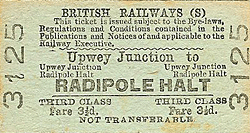 |
twentieth century.
On 2 October 1885 progress in construction was sufficient to allow a trial trip to operate on the line for directors and shareholders. Colonel Rich inspected the line for the Board of Trade on 28 October 1885 and found it satisfactory. Therefore, after eight years, the short branch finally opened to freight and passenger traffic on 9 November 1885, but with little ceremony. Because the station at Upwey Junction was incomplete, a horse-drawn carriage conveyed passengers between Upwey station on the Abbotsbury branch and the original Upwey station on the Dorchester line, half-a-mile north of Upwey Junction. This arrangement continued until Upwey Junction opened on 19 April 1886, replacing the original station. Intermediate stations were at Broadway and Upwey, and a single-road engine shed was provided at the Abbotsbury terminus for the branch locomotive. From the start the line operated under 'one engine in steam'. The 1887 Bradshaw shows five up trains and five down trains with an additional evening service in each direction on Wednesday, and two trains in each direction on Sundays.
 |
An incline was constructed at Portesham to link local quarries on the hill near the Hardy Monument. Once the line had opened it was quickly apparent that the expectations for it could not be fulfilled. There was only a little shale oil and it was not of a quality worth extracting; the iron ore was confined to one small area with no more to be found, and the stone at Portesham had no chance of competing with the extensive quarries at Portland. The extension was soon found to be impractical and once it was established that the line was not going to bring wealth to the area, it settled down to handle purely local traffic, with brisk passenger business at holiday times. On Easter Monday 1886, such was the demand that a double-headed eighteen-coach train ran from the branch to Weymouth in the afternoon. In summer months Abbotsbury Swannery attracted many visitors who reached it by rail.
An accident occurred on 23 January 1894 involving the derailment of an Armstrong tender 0-6-0 locomotive when the train was on the tight curve between Upwey Junction and Upwey stations; this revealed that the curve was sharper than had been indicated in the official plans. A check rail was fitted and a ban introduced on six-coupled locomotives that nominally lasted until the remaining goods spur was reduced to a siding. This change of rules, ironically, meant that in later years these engines could be used by British Railways to service Upwey goods yard after the closure to passengers, even though the only part of the line operational at this point was the curve that had caused the problems. In the meantime this ban left the motive power duties on the line to other designs, notably the 0-4-2Ts which ran for many years. The '517' class gave way to the '14xx' class which were used for passenger and goods traffic until closure.
 |
In August 1896 the company was vested in the Great Western Railway by virtue of the Great Western Railway (Additional Powers) Act of 7 August 1896. The engine shed at Abbotsbury was closed at the end of September 1894, shortly before the line was absorbed by the GWR. By the turn of the century the Sunday service had been withdrawn but it was |
reinstated in 1905 only to be withdrawn again a few years later. It was again reinstated in 1933, lasting until at least 1938. The 1902 Bradshaw shows five trains in each direction on weekdays. As with many branch lines, more convenient road transport and the introduction of motor cars and rural bus services would eventually lead to an irreversible decline in passenger numbers.
Early in the twentieth century the GWR reduced maintenance and wage costs by installing ground-frames to replace signal boxes. In 1905, GWR steam rail-motors were tried on the line. In conjunction with the new rail-motor service, Radipole Halt was opened on the main line between Weymouth and Upwey Junction on 1 July 1905 and Coryates Halt was added to the branch between Broadway and Portesham on 1 May 1906. The rail-motors were intended to stimulate traffic on branch lines, where small and cheap platforms could be built to serve small traffic sources. Unfortunately the lightweight rail-motors could not cope with pulling trailers on hilly lines. After a few years, they were converted into auto-coaches, and the power units were scrapped. Push-and-pull auto trains offered most of the benefits of rail-motor, but because they were operated by 'proper' locomotives they were much more flexible in operation and easier to maintain. The locomotive remained coupled to the carriages and pulled them to Abbotsbury and then pushed them back to Weymouth.
There was a reduction in services during WW1, initially down to four trains a day, but in 1917 this was further reduced to three. With the high demand for oil during the war there was renewed interest in the shale oil deposits. A siding was laid at Corton (near Portesham) to allow the shale to be loaded onto wagons by German prisoners of war, who were brought each day from their camp near Dorchester. In January 1918 there was a proposal to close the line and lift the rails for re-use in France, but this never happened. The Corton shale siding was out of use by September 1921. After the war the branch settled back to a quieter existence with diminishing passenger revenue after the war as the popularity of motor cars increased. This decline continued when a local bus service was established in 1925.
| There was a brief respite for the line during WW2 due to the activity of military installations on Chesil Beach and around the area. Despite stiff competition from road transport, both cars and buses, the 1949 Bradshaw shows an improved service with seven up six down trains with an additional service on Saturdays. The working timetable for 26 September 1949 shows |
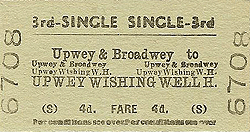 |
the 9.50am down service and the 10.25am and 5.35pm up services as suspended. It also shows an 11.20am Monday - Friday down freight service returning to Weymouth as a mixed service at 1.20pm. Friar Waddon milk platform is also shown. This small platform at the two-mile point of the branch, between Upwey and Coryates, opened in summer 1932, was used to serve the local dairies and even had a Sunday train to get the milk to markets early on Monday morning in the days before domestic refrigeration was common. The platform closed with the line. Additional traffic was brought to the branch in 1935 when camping coaches were placed at Portesham and Abbotsbury stations; Upwey received one the following year. Track improvements were carried out in 1937/8 when standard GWR bullhead rail replaced the original flat-bottomed rails which had been spiked directly to the sleepers.
By 1949 road transport had lured most of the passengers from the Abbotsbury branch, with an average of approximately five passengers on each of the winter trains, and between eight and nine on the trains in summer. In 1950 seven up and seven down trains operated, with an additional Saturday service in both directions. The 10.25am and 1.40pm Saturday-only trains from Abbotsbury ran into Melcombe Regis instead of Weymouth and then continued to Easton.
When the railway system was nationalised on 1 January 1948 the new British Railways Western Region largely corresponded to the extent of the former Great Western Railway lines. However on 2 April 1950 there was a major revision of regional boundaries, one effect of which was to transfer the whole of the main line from Sparkford (just south of Castle Cary) to Weymouth, together with the Abbotsbury, Bridport and Easton branches to the Southern Region. However the existing operating arrangements were continued, with the Western Region providing the passenger train services and showing them in its regional timetable. The Southern Region passenger timetable for winter 1951/2, for example, did not include the Abbotsbury branch.

|
The Easton branch was particularly vulnerable to bus competition as it was paralleled by a main road for most of the way to Portland. Apart from the Bridport - West Bay route, the Easton branch was the first Dorset line to close to passenger traffic (on 3 March 1952) but it was retained for goods traffic. The Abbotsbury branch was also vulnerable to competition |
from buses, the more so because of the indirectness of a journey to Weymouth and the inconvenient siting of the station at Abbotsbury, some distance short of the village. A further disincentive to use the trains was that they made leisurely progress along the line, limited to 40mph, but with a 25mph restriction west of Portesham and 10mph ¼-mile east of Abbotsbury.
Towards the end of the line's existence GWR diesel railcars were used to reduce costs, but they could not prevent its inevitable closure. As the branch never lived up to expectations for goods traffic, despite local protests and an improved service it closed completely on 1 December 1952, with only a short section between Upwey Junction and Upwey (originally Broadway, then Broadwey) remaining open for another nine years to serve the goods depot at Upwey. It was built there because the position of Upwey Junction station on the embankment leading to Bincombe Tunnel had always made that station unsuitable for handling goods traffic.
West of Upwey, the track was lifted in 1955. The last passenger train to travel on any part of the Abbotsbury branch was the REC ‘South Dorset Rail Tour’ on 7 June 1958 which visited Upwey goods depot. The line to Upwey closed to goods traffic on 1 January 1962, and the remaining track was lifted in 1965. Radipole (The ‘Halt’ suffix was dropped in 1969) on the main line remained open until 31 December 1983 when the cost of repairs to the platform could not be justified.
Today just over a mile of the Abbotsbury branch can be walked, from the western edge of Portesham to the site of Abbotsbury station.
Tickets from Michael Stewart, GWR timetable and BR WR working timetable Chris Totty. Route map drawn by Alan Young.
Sources:
Further reading :
See also: Abbotsbury, Portesham, Coryates Halt, Upwey & Radipole Halt |

junction_old6.jpg)

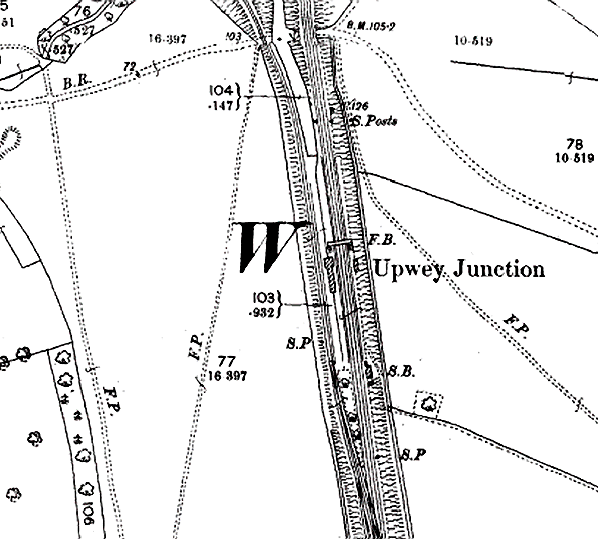
junction_old12.jpg)
junction_old4.jpg)
junction_old9.jpg)
junction_old2.jpg)
junction_old5.jpg)
junction1.jpg)
junction3.jpg)
junction2.jpg)
junction8.jpg)
junction9.jpg)
junction5.jpg)






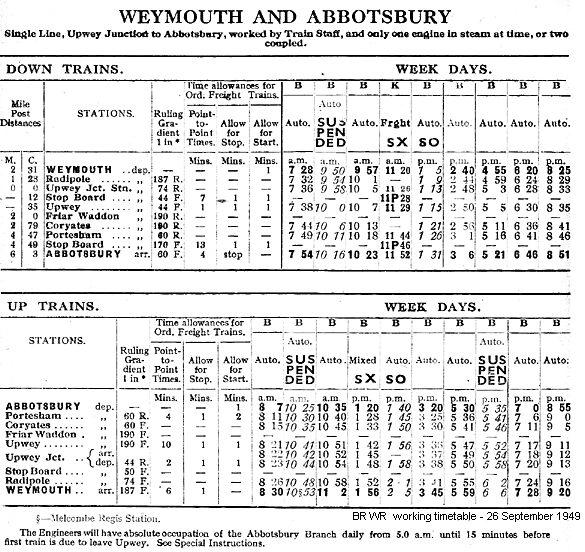



 Home Page
Home Page